What Are a Tower Crane Operator’s Responsibilities Around Power Lines?
What are the responsibilities of a tower crane operator during an overhead lift around power lines? This section of the ASME B30.3 Tower Cranes standard outlines everything a tower crane operator needs to do during an overhead lift.
“Obedience is the other of success, and is wedded to safety.”
The words of Greek tragedian Aeschylus apply well to the lifting and rigging industry, especially as it relates to making overhead lifts.
Safe operations and preventing tragedies in the lifting and rigging industry is the main focus of the American Society of Mechanical Engineers (ASME). When it comes to tower crane operation, the ASME B30.3 Tower Cranes standard dedicates an entire subsection for work done around power lines.
Learning about the safe operation of construction cranes, specifically tower cranes, is the way to ensure your work is done well and everyone returns home in the same condition with which they arrive at work.
In this article, you will learn about:
- Basic operations around power lines
- Operator responsibilities around de-energized & grounded power transmission
- How to operate a tower crane around de-energized power lines other than transmission and distribution lines
- Operator responsibilities with regard to clearance from power lines
What Are the General Operator Responsibilities Around Power Lines?
When the ASME B30 subcommittee updated the ASME B30.3 Tower Cranesstandard, they broke down operation around power lines into several subcategories. They felt it necessary to address several situations where tower cranes could be energized by power lines, including:
- Load handling
- Erecting
- Dismantling
- Inspection
- Maintenance
When working in the vicinity of electric power lines, the requirements below shall be followed to address the hazard:
- To prevent the crane, load line, rigging, lifting devices, or load from becoming a conductive path when operating in the vicinity of energized electric power lines, the specified clearance shall be maintained at all times. There are two ways to establish the voltage in the electrical power lines from which to determine the specified clearance
- Preferred method — have a qualified representative of the utility owner/operator of the electric power lines determine the voltage and elevation of the electric power lines.
- Alternate method — estimate the voltage of the electric power lines by comparing the electric power line support structures to those depicted in Figure 3-3.4.3.1-4. If multiple electric power line support structures are in the vicinity of the work site, use the highest typical voltage shown in Figure 3-3.4.3.1-4. Maintain a specified clearance of 20’ for electric power lines with typical voltages below or equal to 350 kV and a specified clearance of 50’ for electric power lines with typical voltages above 350 kV.
- Operation of cranes where they can become energized by electric power lines shall not be performed unless the requirements of this section are followed.
Additional Precautions
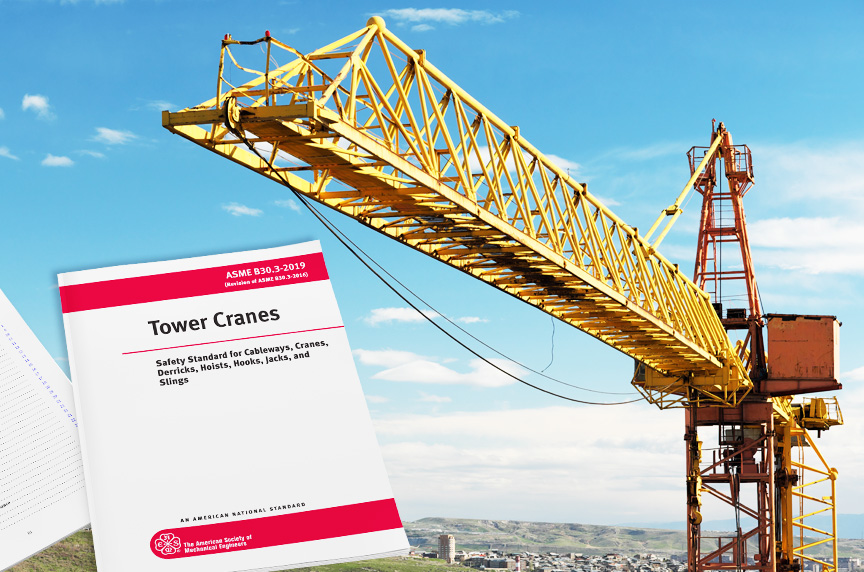
According to the standard, additional precautions “may need to be taken” when the following elements are present:
- Snow
- Ice
- Rain
- Fog
- Wind
- Darkness
- Conditions or environments that affect visibility or induce unwanted movement or position of the crane, loads, or electric power lines.
These precautions or measures may include, but are not limited to:
- Additional spotters
- Warning systems
- Zone restriction systems
- Increased distance from specified clearance, and procedures
Additional Training
Crane operators, signalpersons, riggers, and other involved personnel shall receive training on, as well as an evaluation of, their understanding of, the electrical hazards associated with crane operation in the vicinity of electric power lines, the requirements of this section, and the procedures and emergency responses that are to be implemented should the crane, rigging, lifting devices, load line, or load become energized.
Any overhead wire shall be considered to be an energized electric power line unless and until the utility owner/operator of the electric power lines indicates that it is de-energized, and, for transmission and distribution lines, the electric power lines are visibly grounded at the jobsite. Crane operators and other personnel directly involved with the lifting operations shall not rely on the coverings of wires for protection.
If insulating links, zone restriction systems, or other warning devices are used on cranes, such devices shall not be a substitute for the requirements of this section, even if such devices are required by law or regulation. Electrical hazards are complex, invisible, and lethal. To lessen the potential of false security, instructions related to the devices and hazards shall be reviewed with the crane operator, crew, and load-handling personnel. Instructions shall include information about the electrical hazard(s) involved, operating conditions for the devices, limitations of such devices, and testing requirements prescribed by the device manufacturer. The specified clearances to electric power lines, established in Table 3-3.4.3.1-1, shall be maintained, regardless of any device(s) used on the crane.
Site Supervisor Responsibilities
Before beginning operations, the site supervisor shall ensure the:
- Crane has been configured, located as planned, and verified to be correct
- Area 360° around the crane has been defined up to the maximum reach
- Dimensions of the load(s), rigging, and lifting devices that will be used have been identified
- Preliminary determination is made if any part of the crane, load line, rigging, lifting devices, or load, if operated at the crane’s maximum reach, has the capability to get closer than the specified clearance
- Lift director has the information contained in points 1-4
The lift director shall re-evaluate the information contained in points 1-4 whenever changes that affect the crane configuration or the lift plan are required during operation.
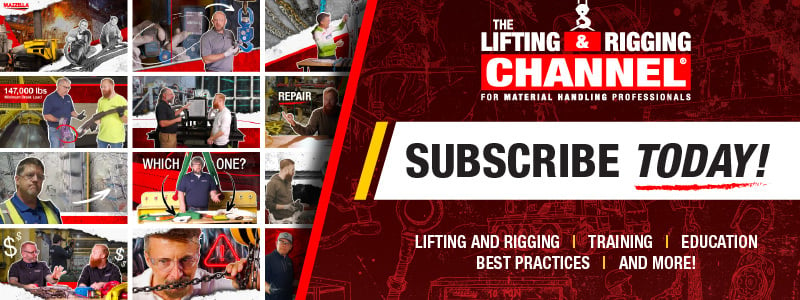
What Are a Tower Crane Operator’s Responsibilities Around De-Energized & Grounded Power Transmission?
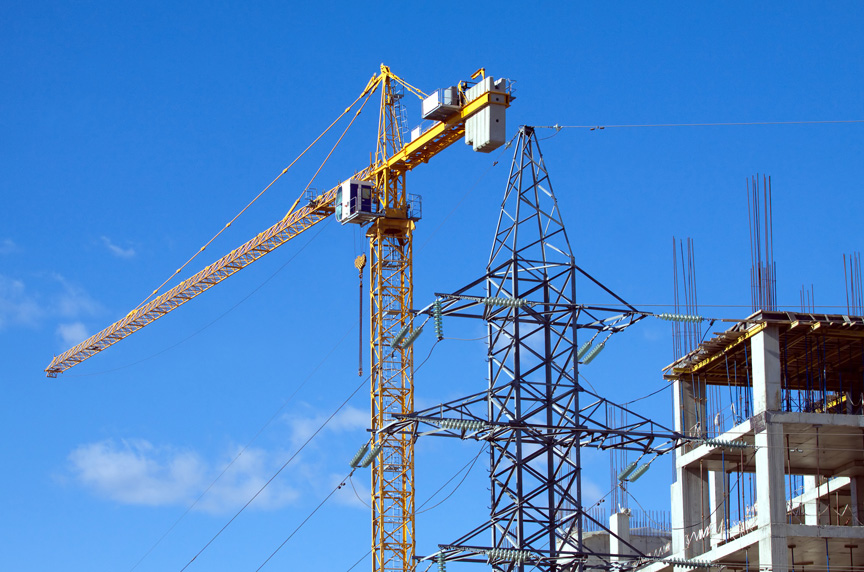
It is “preferred” that a tower crane is operated once the hazard of injury or death due to electrocution has been removed.
The following steps shall be taken to ensure the electric power lines are de-energized:
- The utility owner/operator of the electric power lines shall de-energize the electric power lines.
- The electric power lines shall be visibly grounded to avoid electrical feedback and appropriately marked at the jobsite location.
- A qualified representative of the utility owner/operator of the electric power lines shall come to the site to verify that the steps above have been completed and that the electric power lines are de-energized and grounded.
How Shall a Tower Crane Operator Operate Around De-Energized Power Lines Other than Transmission and Distribution Lines?
Like de-energized and grounded power transmission, this is another “preferred condition” when the crane is required to work in the vicinity of electric power lines that are insulated for the voltage at which they operate since the hazard of injury or death due to electrocution has been removed.
The following steps shall be taken to ensure the electric power lines are de-energized:
- The utility owner/operator of the electric power lines shall de-energize the electric power lines.
- The necessity for grounding the electric power lines shall be determined by the utility owner/operator of the electric power lines.
- A qualified representative of the utility owner/operator of the electric power lines shall come to the site to verify that the steps above have been completed and that the electric power lines are de-energized.
What Are a Tower Crane Operator’s Responsibilities Around Power Lines Within Reach of a Tower Crane?
It is expressly stated that “no part of the crane, load line, rigging, lifting device, or load shall be allowed in the vicinity of an electric power line unless the lines are de-energized” in accordance within the ASME B30.3 Tower Cranes standard.
When the electric power lines remain energized during crane operations in the vicinity of electric power lines, the following are required:
- The horizontal and vertical distance of movement of electric power lines due to the wind, sag, or other conditions, including consideration of lateral drift of the load from wind, pendulation, and inertia, shall be added to the initial specified clearance.
- Evaluate whether the crane, load line, rigging, lifting devices, or load is capable of reaching within the resultant specified clearance.
Minimizing Electrocution Hazards
If any part of the crane, load, or lifting device is within reach of a power line, the following steps must be taken to minimize the electrocution hazard:
- The crane, load line, rigging, lifting devices, or load shall not enter into the resultant specified clearance.
- The lift director shall conduct an on-site planning meeting with the operator and the other workers who will be in the area of the crane or load to review the location of the electric power line(s) and the steps that shall be implemented to prevent encroachment.
- Tag lines, when required, shall be of a nonconductive type. Nonconductive material can become conductive when exposed to moisture or contamination.
- Erect and maintain an elevated warning line, barricade, or line of signs, in view of the operator, equipped with flags or similar high visibility markings to mark the working radius at or farther than the specified clearance distance from the electric power lines.
- Implement at least one of the following measures. If at any time the operator is unable to see the elevated warning line, barricade, or line of signs, a dedicated spotter shall be used in addition to complying with (-b) or (-c) below.
- A dedicated spotter that shall:
- (-a) Be provided with any visual aids required to assist in identifying and maintaining the specified clearance distance
- (-b) Be positioned to accurately gauge the clearance distance
- (-c) Use communication methods that enable the dedicated spotter to communicate directly with the operator
- Give timely information to the operator so that the specified clearance can be maintained
- A device that automatically warns the operator when to stop movement. This device shall be set to give the operator sufficient warning to prevent encroachment.
- A device that automatically limits range of movement, set to prevent encroachment.
What Are a Tower Crane Operator’s Responsibilities When Working Below Energized Power Lines?
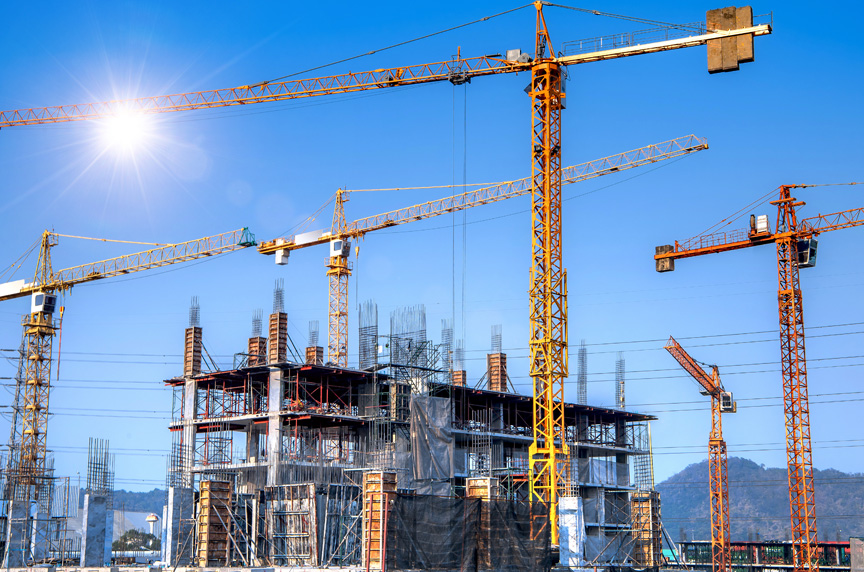
According to the standard, “No part of the crane, load line, or load (including rigging and lifting devices) shall be allowed directly below an electric power line unless the electric power lines are de-energized.”
However, where the electric power lines remain energized during crane operations below electric power lines, the following are required:
- The horizontal and vertical distance of movement of electric power lines due to the wind, sag, or other conditions shall be added to the initial specified clearance. A qualified representative of the utility owner/operator of the electric power lines shall be consulted for specific movement distances.
- Identify if the crane is capable of reaching within the resultant specified clearance. If the load or uppermost part of the crane is capable of entering within the resultant specified clearance, and the crane is operating below energized electric power lines, the requirements of para. 3-3.4.3.6* shall be followed even if the work is not within the specified clearance.
*Paragraph 3-3.4.3.6 outlines the steps for operations within the specified clearance with energized power lines.
What Are a Tower Crane Operator’s Responsibilities Within a Specified Clearance With Energized Power Lines?
Before lifts are done under these conditions, the standard states “the lift director together with a qualified representative of the utility owner/operator of the electric power lines or an engineer qualified in electrical power transmission shall, after visiting the site, determine if this is the most feasible way to complete the operation and set minimum approach distances and procedures for such operations. The procedures developed to comply with this section shall be documented and readily available onsite. These operations shall be under their direct supervision.”
The following shall be required:
- The lift director shall conduct an on-site planning meeting with the operator and the other workers who will be in the area of the crane or load to review the location of the electric power line(s) and the steps that shall be implemented to prevent encroachment.
- Electrical system protective devices that automatically reenergize the circuit after an electrical power line contact occurrence shall be blocked or disengaged to inhibit this function.
Dedicated Spotter Responsibilities
A dedicated spotter shall:
- Be provided with any visual aids required to assist in identifying and maintaining the specified clearance distance
- Be positioned to accurately gauge the minimum approach distances
- Use communication methods that enable the dedicated spotter to communicate directly with the operator
- Give timely information to the operator so that the minimum approach distances can be maintained
Other conditions to be met are:
- An elevated warning line, or barricade (not attached to the crane), in view of the operator (either directly or through video equipment), equipped with flags or similar high-visibility markings, to prevent encroachment on the minimum approach distance.
- If the rigging will be within the specified clearance, it shall be nonconductive.
- If the crane is equipped with a device that automatically limits range of movement, it shall be used and set to prevent any part of the crane, load line, rigging, lifting devices, or load from encroaching the minimum approach distances established.
- Tag lines, when required, shall be of a nonconductive type. Nonconductive material can become conductive when exposed to moisture or contamination.
- Barricades shall be used to form a perimeter to restrict access to the crane work area.
- Nonessential personnel shall be removed and prohibited from the crane work area.
- No one shall be permitted to touch the crane, load line, rigging, lifting devices, or load unless the lift director indicates it is safe to do so.
- The crane shall be grounded in accordance with the manufacturer’s or a qualified person’s written instructions.
- Insulated barriers shall be installed by the utility owner/operator of the electric power lines, except where such devices are unavailable for the line voltages involved. Installation of such barriers are not a substitute for compliance with this section.
What Can Mazzella Do to Help You Stay in Compliance with the ASME B30.3 Tower Cranes Standard?
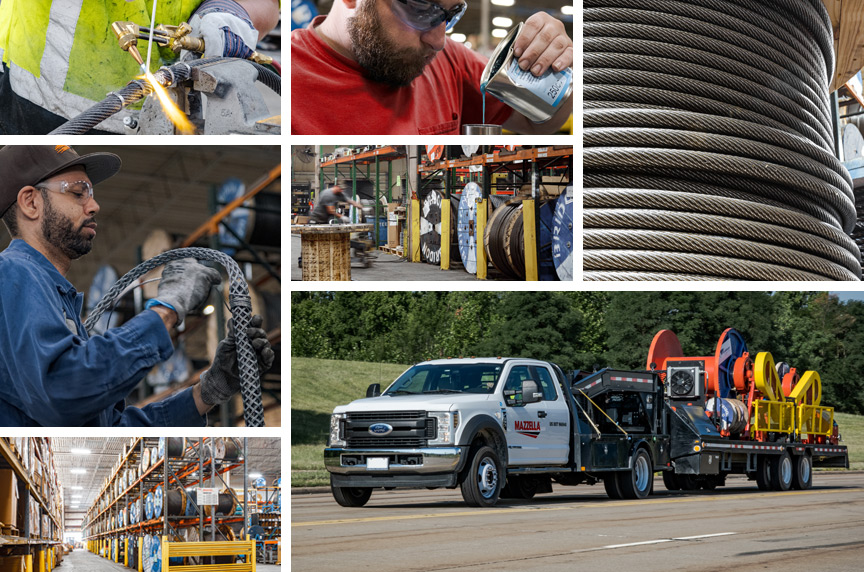
Mazzella partners with a third-party company, Industrial Training International (ITI), to provide training for crane operators. ITI training courses are offered for mobile cranes (including boom truck, carry deck, rough terrain, and crawler cranes), overhead cranes, articulating boom cranes, pedestal cranes and tower cranes.
ITI offers Tower Crane Certification that provides training to prepare its participants for exams from the National Commission for the Certification of Crane Operators (NCCCO). This is a four-day, in-person training course at ITI’s Morrow Crane Training Center in Salem, Oregon. Additionally, ITI offers a three-day, instructor-led tower crane safety and inspection course.
Tower Crane Ropes
Also, Mazzella is a one-stop-shop for high-performance crane ropes, or any kind of specialty ropes. We have fittings and sockets that can be installed in the field, and a large inventory of ropes in stock that allows us to help get you back up and running as quickly as possible.
Mazzella has one of the largest specialty rope inventories in the United States…ready for immediate delivery! We provide wire rope assemblies, and manufacture bridge cables, crane cables, steel mill cables, and thousands of OEM (original equipment manufacturer) assemblies:
- In sizes from ¼” to 3” diameter and 9mm to 52mm diameter
- Domestic and Non-Domestic
- In stock and ready for same or next-day shipment from one of our many service centers
In addition to crane ropes installations and inspections, Mazzella has the capabilities to do button and OEM socket installations. We have technicians around the country who have been trained to do:
- Socket installs
- Perform crane rope inspections
Call us at 800.362.4601 or click here if you need wire rope products or assemblies.
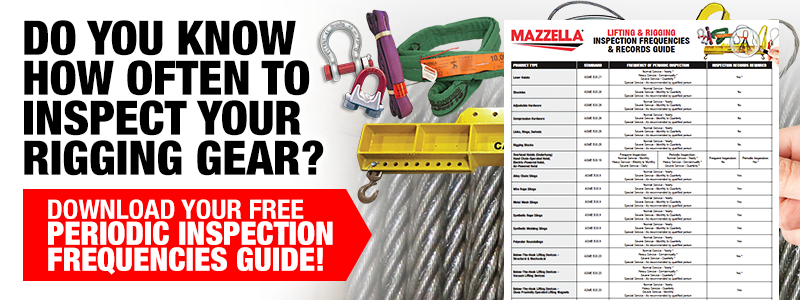

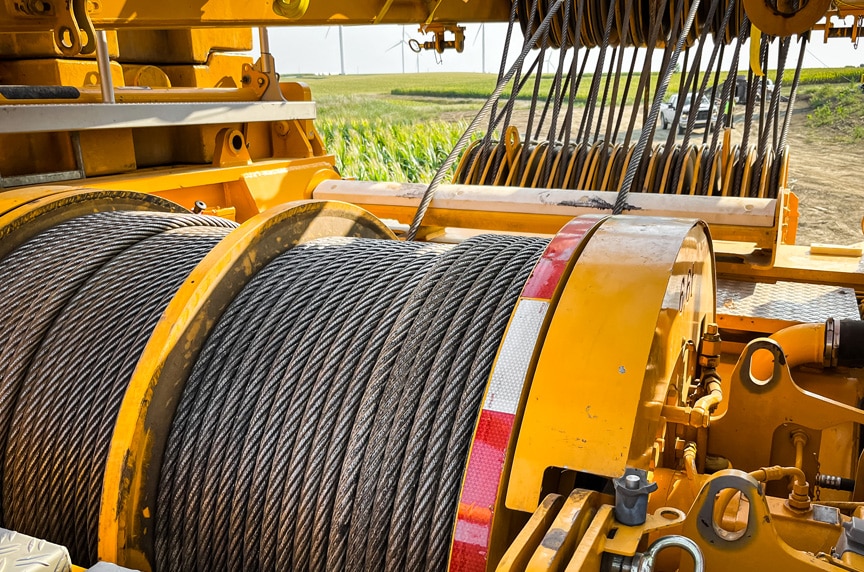
Crane Ropes
One Brand of Rope Will Not Work on Every Machine!
Mazzella stocks a large inventory of high-performance wire ropes available for immediate delivery.
Copyright 2023. Mazzella Companies.
